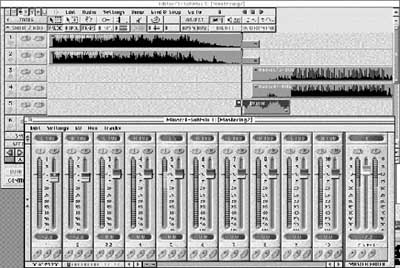
Project Mastering with PARIS
By Craig Anderton
Home digital mastering is the next logical step after home digital recording - it's a natural progression from having control over the tracks we record to controlling the final stereo mix. But isn't it common knowledge that mastering is an arcane skill, mastered only by the few who have both golden ears and a mystical bond with Very Expensive Equipment? Read on, and judge for yourself.
On the other hand, one way to get that experience is to roll up your sleeves and do it yourself. If nothing else, you'll be able to appreciate the role of mastering better, and communicate more effectively should you ever need to use professional mastering services.
Aside from putting songs in order, the mastering process addresses several issues:
PARIS currently lets you do all of these except for cleanup, which can be addressed with DirectX and VST plug-ins. Furthermore, PARIS's 24-bit resolution really helps in the mastering process, as it maintains the music's full dynamic range from the first track to the final mix.
Slide the tracks into the desired position. For some transitions between songs, you might want a few seconds of silence. Or, perhaps a crossfade is the way to go. Either type of transition is easy to do with PARIS. Yet another option is to overdub some other sound during transitions - a sound effect, perhaps, or nifty filter sweep (Fig. 1).
Now, use the mixer controls to match apparent levels among the various songs. A little EQ can compensate for tonal differences. Does one tune need a bit more punch? Toss a compressor into its insert. You can even get creative, like programming a reverb splash to hang over from one song, while the next song fades in.

The best part about all this is the automation, which allows storing all the parameters you've adjusted. Go to the beginning, press Play, then run off a DAT, CD, or cassette copy. Listen to your project for several days, over a variety of systems, and take notes about any changes you want to make. Keep tweaking until you're satisfied, make your final two-track mix, and there you have it - an assembled album, ready for CD preparation and any final mastering you want to add.
- Always work on copies. If you've mixed to hard disk, then back up the mixes before
importing them into a new Project.
- Don't fade out or in when mixing. Fades are best left for the mastering process; if a
fade is "built in" to a mix, you can't change it.
- Use normalization sparingly. Theoretically, normalization sounds like a great idea:
click a button to amplify your signal so that the peaks just reach the maximum available
dynamic range. But music doesn't work like that. A heavily compressed tune may seem much
louder than a less compressed tune whose peaks are actually higher.
- Have a reference CD handy. Compare what you're doing to a well-engineered,
well-mastered CD. If the reference CD sounds more tonally balanced than your songs,
analyze the difference, and apply appropriate EQ to compensate.
- Louder is not always better. Sometimes it seems like there's a rock and roll arms race
going to see who can put the most level possible on a CD. Truce! CDs have great dynamic
range, yet many tunes live within the space of -10 to 0 dB. The result may sound punchy
and jump out of the speakers, but a whole CD of maximum level songs can be pretty
fatiguing. There's more to music than fortissimo.
- Use a consistent 44.1 kHz sampling rate. Your CD is going to end up at 44.1 kHz, so you might as well start there. Using other sampling rates requires a format conversion to 44.1 kHz.
Don't think that you'll master on the same level as the pros on your first attempt. But the
way to become a master is through practice, and PARIS makes it real easy to experiment.
Meanwhile, if you take a shot at mastering at home, you can go at least go into a "real"
mastering suite confident that you know the right order for your tunes, and what fixes
need to be made. That alone can save you time and money, and produce a better final
result.
© 1999, Craig Anderton. All Rights Reserved. Used by permission.
By his 22nd birthday, Craig Anderton had recorded three albums with the Philadelphia-based
group "Mandrake Memorial," toured most of the USA, and played at Carnegie Hall. Craig is a
prolific author, having written the classic work Home Recording For Musicians,
several other books, and numerous articles for such magazines as EQ, Guitar Player, Keyboard, Musician, Performing Songwriter, Pro Audio Netherlands, and several others. He
is currently Technology Editor for EQ magazine, Consulting Editor for Guitar Player
magazine, and a monthly columnist for Keyboard.
© 2002 All Rights Reserved E-MU / ENSONIQ